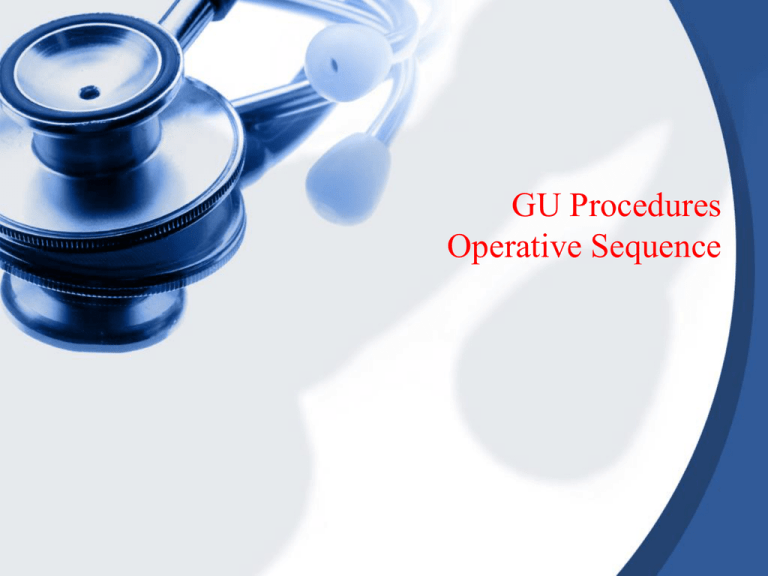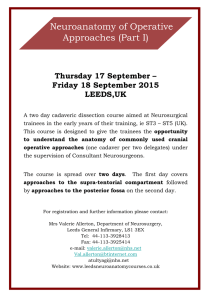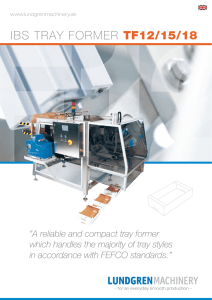
GU Procedures
Operative Sequence
Circumcision
• Overall Purpose of Procedure:
– Performed to prevent infection and inflammation
of the glans.
– a lower risk of urinary tract infections, penile
cancer and sexually transmitted diseases.
– Circumcision may also be used to treat Phimosis:
a constriction of the opening of the foreskin so
that it cannot be drawn back over the tip of the
penis.
Circumcision
• Define the procedure:
– Circumcision is the removal of some or all
of the foreskin (Prepuce) from the penis
Circumcision
• Wound Classification: 1
Operative Sequence
•
•
•
•
•
•
•
•
•
1- Incision
2- Hemostasis
3- Dissection
4- Exposure
5- Procedure (Specimen Collection possible)
6- Hemostasis
7- Irrigation
8- Closure
9- Dressing Application
Circumcision
• Instrumentation: Minor Instrument Tray/ Ped
Tray (age specific).
• What basic instruments will you expect to see in
this tray?
• Positioning: The patient is in supine position,
arms tucked at the side or on arm boards. Surgeon
stands on the left side of the patient.
• Prepping: Surgeon preference. Hibiclense or a
Betadine Prep Kit. Prep groin area and far lateral
on both sides.
• Draping: Standard draping procedure. 4 towels
and a lap drape. Ask about towel clips.
– Age specific – if ped- MD might want ped drape.
Circumcision
cont. Operative Sequence
• Dissection and
Exposure:
– Clamps are
placed on the
edge of the
prepuce.
Circumcision
cont. Operative Sequence
• Hemostasis: Handheld Bovie, hemostats,
and free ties are utilized.
Circumcision
Begin your Operative Sequence
• Incision: 15 kb
on #3 handle or
Iris scissors for
incision.
Circumcision
cont. Operative Sequence
• Exploration
and
Isolation:
Any?
Circumcision
cont. Operative Sequence
• Surgical
Repair/Removal/Specimen
Collection:
– Iris, Tenotomy or
Metz.
– Long Incision on the
dorsal side of the
foreskin.
– Incision is continued
round the foreskin,
circumferentially.
Circumcision
cont. Operative Sequence
• Hemostasis and Irrigation:
– All bleeding is controlled with cautery.
– Use of warm Saline to irrigate.
Circumcision
cont. Operative Sequence
• Closure:
– Wound edges
are brought
together with
small absorbable
suture.
– Incision is
dressed with wet
gauze, petroleum
impregnated
gauze.
Circumcision
• Major Arteries:
– The dorsal arteries, which
run in the interval between
the corpora cavernosa on
each side of the deep dorsal
vein.
– The dorsal and deep
arteries are branches of the
internal pudendal arteries.
– The deep arteries are the
principal vessels that supply
the cavernous spaces
(erectile tissue) in the three
corpora.
Circumcision
• Major Veins:
– Blood from the
cavernous spaces is
drained by a venous
plexus that joins the deep
dorsal vein located in the
deep fascia.
• Major Nerves:
– pudendal nerve.
GU Procedures
Operative Sequence
Orchidopexy
(aka – Orchiopexy)
Orchidopexy
• Define the procedure:
• to move an undescended testicle into the scrotum
• Overall Purpose of Procedure:
• Relieve Cryptorchidism - a medical term referring to
absence from the scrotum of one or both testes. This
usually represents failure of the testis to move, or
"descend," during fetal development. Can lead to
sterility due to heat in the abdomen.
• Orchiopexy can also be performed to resolve a
testicular torsion. If caught early enough and the blood
supply can be restored to the testicle, this operation can
be performed to prevent further occurrence of torsion.
Orchidopexy
• Wound Classification: 1
Operative Sequence
•
•
•
•
•
•
•
•
•
1- Incision
2- Hemostasis
3- Dissection
4- Exposure
5- Procedure (Specimen Collection possible)
6- Hemostasis
7- Irrigation
8- Closure
9- Dressing Application
Orchidopexy
• Instrumentation: Minor Tray
• Positioning: The patient is in supine position arms on arm
boards.
• Prepping: Surgeon preference. Hibiclense or a Betadine
Prep Kit. Prep from pubic line to iliac crest to groin and
far lateral on both sides.
• Draping: 4 towels and a lap drape. Ask about towel clips.
Orchidopexy
Begin your Operative Sequence
• Incision: 15 kb on #3
handle for incision.
• Incision over the external
ring, extended into the deep
inguinal ring.
• Anything wrong with this
picture?
Orchidopexy
cont. Operative Sequence
• Hemostasis: Handheld Bovie and hemostats are
utilized.
Orchidopexy
cont. Operative Sequence
• Dissection and
Exposure:
• Metz for
dissection.
• Blunt dissection
also used to ID
Spermatic cord.
Orchidopexy
cont. Operative Sequence
• Exploration
and Isolation:
• The spermatic cord is
freed high into the
inguinal ring to provide
enough slackness for the
testicle to fall into the
scrotum.
Orchidopexy
cont. Operative Sequence
• Surgical
Repair/Removal/Specimen
Collection:
• A tunnel must be created
thru the external oblique
fascia for the testicle to
follow into the scrotum.
• This tunnel can be created
with blunt dissection or a
kelly clamp.
Orchidopexy
cont. Operative Sequence
• Surgical
Repair/Removal/Speci
men Collection:
• A small incision is made
into the scrotum to expose
the scrotal septum.
• The testicle is moved thru
the tunnel into the
scrotum.
• Sutures (Chromic) are
placed into the testicle and
scrotal septum to hold
testicle into place.
Orchidopexy
cont. Operative Sequence
• Hemostasis and Irrigation:
• Controlled with ESU.
• Warm Saline
• Closure:
• Surgeon choice – Chromic with Bacitracin oint.
Orchidopexy
• Major Arteries:
• external and internal
pudendal arteries
• Major Veins:
• The scrotal veins
accompany the
arteries and join the
external pudendal
veins.
GU Procedures
Operative Sequence
Simple Nephrectomy
Simple (Open) Nephrectomy
• Overall Purpose of Procedure:
• The reasons for performing a simple
nephrectomy include:
• Cancer in the kidney.
• Large stones in the kidney.
• The kidney may be damaged and very small,
causing high blood pressure.
• The kidney may have an infection that
antibiotic treatment cannot cure.
Simple vs Radical
• A simple nephrectomy is indicated in patients with
irreversible kidney damage due to symptomatic chronic
infection, obstruction, calculus disease, or severe traumatic
injury.
• Simple nephrectomy is also indicated to treat renovascular
hypertension due to noncorrectable renal artery disease or
severe unilateral parenchymal damage caused by
nephrosclerosis, pyelonephritis, reflux dysplasia, or
congenital dysplasia of the kidney.
• Sometimes, just a part of the kidney may be removed
Simple vs Radical
• Radical nephrectomy is the treatment of choice for
localized renal cell carcinoma (RCC). In certain
circumstances, radical nephrectomy is also
indicated to treat locally advanced RCC and
metastatic RCC.
• Radical nephrectomy remains the procedure of
choice for surgically resectable lesions.
• Your surgeon will also take out the adrenal gland
and some lymph nodes.
Simple Nephrectomy
• Define the procedure:
• A simple nephrectomy is removal of an entire
kidney.
• Wound Classification: 1 WHY IS IT A
CLASS 1?
Operative Sequence
•
•
•
•
•
•
•
•
•
1- Incision
2- Hemostasis
3- Dissection
4- Exposure
5- Procedure (Specimen Collection possible)
6- Hemostasis
7- Irrigation
8- Closure
9- Dressing Application
Simple Nephrectomy
• Instrumentation: Major Tray, Long Abdominal Tray, Self
Retaining Ret x2, Chest/Rib Tray (if you facility has one) Have
Vascular tray in room -hold
• What basic instruments will you expect to see in the
Chest/Rib tray?
• Positioning: The patient is in lateral kidney position, lower arm
tucked at the side or on an arm board, upper arm on arm board/
airplaned. 2 Surgeons for this procedure. One in front of and
one in back of patient.
• Prepping: Surgeon preference. Duraprep, Hibiclense or a
Betadine Prep Kit. Prep from nipple line to iliac crest and far
lateral on both sides.
• Draping: 4 towels and a lap drape. Ask about towel clips.
Simple Nephrectomy
Begin your Operative Sequence
• Incision: 10 kb on #3
handle for incision.
• Flank incision
• Incision over or between the
11th or 12th rib.
• Another approach – less
used- incision under the rib
cage.
Simple Nephrectomy
Begin your Operative Sequence
• Incision:
• If the surgeon(s) wants to remove the rib,
instead of going between the ribs:
• Need Doyen rib rasp to remove the
periosteum from the bone.
• Have rib shear ready to remove bone.
• Usually not sent as a specimen.
• Do not take home with you for rib roast.
Simple Nephrectomy
cont. Operative Sequence
• Hemostasis: Handheld Bovie, hemostats,
Hemoclips, and free ties are utilized.
Simple Nephrectomy
cont. Operative Sequence
• Dissection and
Exposure:
• Self retaining
retractor is placed
in wound.
• Some surgeons use
two Balfours.
Simple Nephrectomy
cont. Operative Sequence
• Exploration
and Isolation:
• Incision is made thru the
subcutaneous and oblique
muscles.
• Gerota's Capsule is ID’d
• A fibrous envelope of
tissue that surrounds
the kidney. Also
called renal fascia
and Gerota's fascia.
Simple Nephrectomy
cont. Operative Sequence
• Surgical
Repair/Removal/Specimen
Collection:
• The ureter is identified,
clamped and ligated.
• The kidney pedicle and
renal Artery and Renal
Vein are clamped and
ligated.
• Renal Vessels are usually
triple clamped/tied for
safety.
Simple Nephrectomy
cont. Operative Sequence
• Surgical Repair/Removal/Specimen
Collection:
• Care is taken to not damage the ureter.
• The kidney is then mobilized with blunt
dissection.
• The kidney is then removed from the
wound.
• Check the pedicle vessels for bleeding.
Simple Nephrectomy
cont. Operative Sequence
• Hemostasis and Irrigation:
• Controlled with ESU and chemical hemostasis.
• Warm Saline
• Closure:
• Surgeon choice
• Are we putting the rib back?
Simple Nephrectomy
• Major Arteries:
• Renal Arteries
Simple Nephrectomy
• Major Veins:
• The renal veins drain into
the IVC.
• Major Nerves:
• renal plexus
Lap Hand Assisted Nephrectomy
• Watch this video!
• This is how most
nephrectomies are
completed today.
• Hand Assisted
GU Procedures
Operative Sequence
Cysto and TURP
Suprapubic Prostatectomy
Cystoscopy
• Cystoscopy is a
procedure that
allows the doctor to
look at the inside of
the bladder and the
urethra using a thin,
lighted instrument
called a cystoscope
Cysto
Cysto
Cysto
• Cystoscopy may be done to:
• Find the cause of symptoms such as blood in
the urine (hematuria), painful urination
(dysuria), urinary incontinence, urinary
frequency or hesitancy, an inability to pass
urine (retention), or a sudden and
overwhelming need to urinate (urgency).
Cysto
• Find the cause of problems of the urinary tract, such
as frequent, repeated urinary tract infections or
urinary tract infections that do not respond to
treatment.
• Look for problems in the urinary tract, such as
blockage in the urethra caused by an enlarged
prostate, kidney stones, or tumors
• Evaluate problems that cannot be seen on X-ray or to
further investigate problems detected by ultrasound
or during intravenous pyelography (IVP), such as
kidney stones or tumors.
Cysto
• Remove tissue samples for biopsy.
• Remove foreign objects.
• Place ureteral catheters (stents) to help urine flow from the
kidneys to the bladder.
• Treat urinary tract problems. For example, cystoscopy can be
done to remove urinary tract stones or growths, treat bleeding in
the bladder, relieve blockages in the urethra, or treat or remove
tumors.
• Place a catheter in the ureter for an X-ray test called retrograde
pyelography. A dye that shows up on an X-ray picture is
injected through the catheter to fill and outline the ureter and the
inside of the kidney.
(TRANSURETHRAL RESECTION OF
PROSTATE).
During transurethral resection of the prostate
(TURP), an instrument is inserted up the
urethra to remove the section of the prostate
that is blocking urine flow.
TURP is now the most common surgery used
to remove part of an enlarged prostate. Open
prostatectomies (in which an incision is made
into the abdomen) generally are needed only
when the prostate is very large.
Old School: Glycine is fluid of choice
New School: NACL!!! Usually the team will
not use NACL due to the fact that they can’t
use the electrode needed for a TURP with
NACL present. However, too much NACL
will throw the fluid balance of your patient off.
Your pt can end up with fluid toxicity!
New systems are bipolar instead of monopolar.
Suprapubic Prostatectomy
Suprapubic Prostatectomy
Suprapubic Prostatectomy
• Overall Purpose of Procedure:
– Performed to treat BPH (benign prostatic
hypertrophy) and for cancer of the prostate.
– Inguinal nodes may be removed for diagnosis of
metastasis.
Suprapubic Prostatectomy
• Define the procedure:
– The prostate gland is removed via a suprapubic
(above the pubic bone) incision.
– Three primary approaches are commonly employed:
• Suprapubic - removal through an incision above
the pubis and through the urinary bladder;
• Retropubic – same incision as for suprapubic but
without entering the urinary bladder
• Transurethral (TRANSURETHRAL RESECTION
OF PROSTATE).
Radical vs Simple
• Radical vs Simple Prostatectomy
– Radical – nerve sparing
– Simple – not so much! Simple coring of the
prostate. No nerves spared.
Suprapubic Prostatectomy
• The major advantage of the suprapubic
approach over the retropubic approach is that
it permits better visualization of the bladder
neck and ureteral orifices and, therefore, is
better suited for patients with the following
conditions:
–
–
–
–
Enlarged, protuberant, median prostatic lobe
Bladder diverticulum
Large bladder calculi
Obesity (to a degree that makes access to the
retropubic space more difficult)
Bladder Diverticulum
Suprapubic Prostatectomy
• Wound Classification: 2
Operative Sequence
•
•
•
•
•
•
•
•
•
1- Incision
2- Hemostasis
3- Dissection
4- Exposure
5- Procedure (Specimen Collection possible)
6- Hemostasis
7- Irrigation
8- Closure
9- Dressing Application
Suprapubic Prostatectomy
• Instrumentation: Major Tray, Long Abdominal Tray, Self
Retaining Ret, Prostate Tray (if you facility has one) Have
Vascular tray in room -hold
– What basic instruments will you expect to see in the Prostate tray?
McDougal?
• Positioning: The patient is in supine position (possible low
Lithotomy), arms tucked at the side or on arm boards. Surgeon
stands on the left side of the patient. Slight Trendelenburg
possible, might need shoulder boards.
• Prepping: Surgeon preference. Duraprep, Hibiclense or a
Betadine Prep Kit. Prep mid-chest to groin area and far lateral
on both sides. Watch for pooling of prep around groin. Catheter?
• Draping: 4 towels ( Top, side, side, under scrotum) and a lap
drape. Ask about towel clips.
Suprapubic Prostatectomy
Begin your Operative Sequence
• Incision: 10 kb on #3
handle for incision.
• Made into the space of
Retzius (named after a
Swedish professor of anatomy,
Anders Retzius.)
• The separation of
transversalis fascia and
peritoneum contains
loose fatty tissue allowing
for the filling of the
bladder. This space is
called the retropubic
space of Retzius.
Suprapubic Prostatectomy
cont. Operative Sequence
• Hemostasis: Handheld Bovie, hemostats,
Hemoclips, and free ties are utilized.
Suprapubic Prostatectomy
cont. Operative Sequence
• Dissection and
Exposure:
– Self retaining
retractor is placed
in wound.
– Have MANY
sutures available.
– Chromic, Vicryl,
Monocryl etc.
Suprapubic Prostatectomy
cont. Operative Sequence
• Exploration
and Isolation:
– 2 traction sutures or Allis
Clamps are placed in the
bladder wall and an
incision is made between
them (cystotomy).
– The bladder wall edges
are them lifted up and
away, providing
visualization of the
bladder neck, ureters and
prostate.
Suprapubic Prostatectomy
cont. Operative Sequence
• Surgical Repair/Removal/Specimen
Collection:
–
–
–
–
Prostate mucosa is incised with the ESU.
Bladder neck is incised with the ESU.
Urethra is transected.
Enucleation = in this case it means to remove
the prostate en bloc without trauma to the bed
of the tissue.
• (Enucleation usually refers to the removal of the eye,
leaving the eye muscles and remaining orbital
contents intact)
Suprapubic Prostatectomy
cont. Operative Sequence
• Surgical Repair/Removal/Specimen
Collection:
– This is where the book goes into closure.
– What step have we not covered?
Suprapubic Prostatectomy
cont. Operative Sequence
• Surgical Repair:
– We must reattach the urethra!
• Using 2-0 Vicral sutures on
5-8 circle tapered needles,
full thickness sutures are
placed at 12, 3, 6, and 9
o'clock positions through the
urethral mucosa, smooth
muscle, striated urethral
sphincter, and fascia. At the
6 o'clock position the suture
is placed with care to avoid
injuring the neurovascular
bundles, which are located
posterior to the striated
sphincter. At the 12 o'clock
position the suture
incorporates the anterior
dorsal vein/striated urethra
sphincter hood.
Suprapubic Prostatectomy
cont. Operative Sequence
• Hemostasis and Irrigation:
– Many, many, many chromic and Vicryl sutures and
hemoclips and ESU
– Warm Saline
• Closure:
– Surgeon choice
Suprapubic Prostatectomy
• Major Arteries:
– the inferior vesical
and middle rectal
arteries which are
branches of the
internal iliac artery.
Suprapubic Prostatectomy
• Major Veins:
– prostatic venous plexus
around the sides and base
of the prostate which
drains into the internal iliac
veins.
• Major Nerves:
– Parasympathetic fibers
arise from the pelvic
splanchnic nerves (S2, S3,
and S4).
– The sympathetic fibers are
from the inferior
hypogastric plexuses.
Vids
•
Robotic: Weill Cornell Robotic
Prostatectomy
• Actual View: Nerve
Sparing Prostate
Cancer
Penile Implant
Penile Implant
Implants
• Penile implants are artificial devices implanted
inside the penis that allow men with erectile
dysfunction (ED) to achieve an erection. They're
also sometimes used to treat Peyronie's disease, a
disorder that causes bent or painful erections.
• There are two basic designs of implants:
• Inflatable. Also called hydraulic, inflatable implants
can be pumped up to create an erection and then
deflated.
• Semirigid. These implants are always somewhat
firm.
History
• First introduced in the 1970s, penile
implants were the most reliable treatment
for erectile dysfunction until the 1980s
when medications injected into the penis
became available. In the 1990s, oral
agents such as sildenafil (Viagra) were
introduced.
There are two basic types of penile
implants
• 1) Semirigid rods.
• This type of implant is always firm. The
penis may be bent away from the body to
have sex and toward the body to conceal
the device.
Old School
• Old School manual
implant.
New School
2) Inflatable implants
• Three-piece implants use a fluid-filled reservoir
implanted under the abdominal wall, a pump-andrelease valve placed inside the scrotum, and two
inflatable cylinders inside the penis. Before sex, the
patient pumps the fluid from the reservoir into the
cylinders to cause an erection. After sex, the pt
release the valve inside the scrotum to drain the
fluid back into the reservoir.
• The two-piece model currently available in the
United States works in a similar way to a three-piece
design, but the fluid reservoir is part of the pump
mechanism implanted in the scrotum.
New School
• Pumps in
abdomen, thigh or
scrotum.
• In the United States, inflatable devices are
the most common type of penile implant.
• Three-piece inflatable devices are used in
about 70 percent of penile implants.
• Two-piece inflatable devices are used
about 20 percent of the time.
• Semirigid devices are the least used,
accounting for about 10 percent of
implants.
• Penile Implant - Minimally Invasive Perito
Technique
• A “must watch” video!










